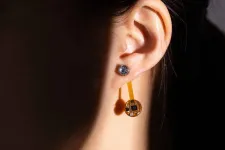(Press-News.org) Smart accessories are increasingly common. Rings and watches track vitals, while Ray-Bans now come with cameras and microphones. Wearable tech has even broached brooches. Yet certain accessories have yet to get the smart touch.
University of Washington researchers introduced the Thermal Earring, a wireless wearable that continuously monitors a user’s earlobe temperature. In a study of six users, the earring outperformed a smartwatch at sensing skin temperature during periods of rest. It also showed promise for monitoring signs of stress, eating, exercise and ovulation.
The smart earring prototype is about the size and weight of a small paperclip and has a 28-day battery life. A magnetic clip attaches one temperature sensor to a wearer’s ear, while another sensor dangles about an inch below it for estimating room temperature. The earring can be personalized with fashion designs made of resin (in the shape of a flower, for example) or with a gemstone, without negatively affecting its accuracy.
Researchers published their results Jan. 12 in Proceedings of the ACM on Interactive, Mobile, Wearable and Ubiquitous Technologies. The device is not currently commercially available.
“I wear a smartwatch to track my personal health, but I’ve found that a lot of people think smartwatches are unfashionable or bulky and uncomfortable,” said co-lead author Qiuyue (Shirley) Xue, a UW doctoral student in the Paul G. Allen School of Computer Science & Engineering. “I also like to wear earrings, so we started thinking about what unique things we can get from the earlobe. We found that sensing the skin temperature on the lobe, instead of a hand or wrist, was much more accurate. It also gave us the option to have part of the sensor dangle to separate ambient room temperature from skin temperature.”
Creating a wearable small enough to pass as an earring, yet robust enough that users would have to charge it only every few days, presented an engineering challenge.
“It’s a tricky balance,” said co-lead author Yujia (Nancy) Liu, who was a UW masters student in the electrical and computer engineering department when doing the research and is now at the University of California San Diego. “Typically, if you want power to last longer, you should have a bigger battery. But then you sacrifice size. Making it wireless also demands more energy.”
The team made the earring’s power consumption as efficient as possible, while also making space for a Bluetooth chip, a battery, two temperature sensors and an antenna. Instead of pairing it with a device, which uses more power, the earring uses Bluetooth advertising mode — the transmissions a device broadcasts to show it can be paired. After reading and sending the temperature, it goes into deep sleep to save power.
Because continuous earlobe temperature has not been studied widely, the team also explored potential applications to guide future research. In five patients with fevers, the average earlobe temperature rose 10.62 degrees Fahrenheit (5.92 degrees Celsius) compared with the temperatures of 20 healthy patients, suggesting the earring’s potential for continuous fever monitoring.
“In medicine we often monitor fevers to assess response to therapy — to see, for instance, if an antibiotic is working on an infection,” said co-author Dr. Mastafa Springston, a clinical instructor at the Department of Emergency Medicine in the UW School of Medicine. “Longer term monitoring is a way to increase sensitivity of capturing fevers, since they can rise and fall throughout the day.”
While core body temperature generally stays relatively constant outside of fever, earlobe temperature varies more, presenting several novel uses for the Thermal Earring. In small proof-of-concept tests, the earring detected temperature variations correlated with eating, exercising and experiencing stress. When tested on six users at rest, the earring’s reading varied by 0.58 F (0.32 C) on average, placing it within the range of 0.28 C to 0.56 C necessary for ovulation and period tracking; a smartwatch varied by 0.72 C.
“Current wearables like Apple Watch and Fitbit have temperature sensors, but they provide only an average temperature for the day, and their temperature readings from wrists and hands are too noisy to track ovulation,” Xue said. “So we wanted to explore unique applications for the earring, especially applications that might be attractive to women and anyone who cares about fashion.”
While researchers found several promising potential applications for the Thermal Earring, their findings were preliminary, since the focus was on the range of potential uses. They need more data to train their models for each use case and more thorough testing before the device might be used by the public. For future iterations of the device, Xue is working to integrate heart rate and activity monitoring. She’s also interested in potentially powering the device from solar or kinetic energy from the earring swaying.
“Eventually, I want to develop a jewelry set for health monitoring,” Xue said. “The earrings would sense activity and health metrics such as temperature and heart rate, while a necklace might serve as an electrocardiogram monitor for more effective heart health data.”
Joseph Breda, a doctoral student in the Allen School, was a co-author on the paper. Vikram Iyer, a professor in the Allen School, and Shwetak Patel, a professor in the Allen School and the electrical and computer engineering department, were co-senior authors. This research was funded by the Washington Research Foundation.
For more information, contact Xue at qxue2@cs.washington.edu and Liu at yul276@ucsd.edu.
For questions specifically for Dr. Mastafa Springston, please contact Susan Gregg at sghanson@uw.edu.
END
UW-developed smart earrings can monitor a person’s temperature
2024-02-07
ELSE PRESS RELEASES FROM THIS DATE:
Quantum simulation with ultracold fermions unveils pairing pseudogap
2024-02-07
A research team led by Professors PAN Jianwei, YAO Xingcan, and CHEN Yu'ao from the University of Science and Technology of China (USTC) of the Chinese Academy of Sciences, have for the first time observed and quantitatively characterized the many-body pairing pseudogap in unitary Fermi gases. This achievement, pursued by the ultracold atomic community for nearly two decades, resolves longstanding debates regarding the existence of a pairing pseudogap in these gases. It also supports ...
New research uncovers biological drivers of heart disease risk
2024-02-07
New gene mapping technique reveals how genetic alterations in cells lining blood vessels contribute to coronary artery disease, with implications for diagnostic and treatment strategies.
KEY TAKEAWAYS
Researchers from the Brigham, the Broad Institute, and Stanford Medicine studied how "deleting" individual genes associated with coronary artery disease (CAD) impacted the expression of all the other genes in a cell to better understand underlying biology of CAD.
The study focused on endothelial cells, which line blood vessels and are increasingly understood to influence CAD risk.
The researchers highlighted a previously unrecognized role for the TLNRD1 gene ...
Resting boosts performance of lithium metal batteries
2024-02-07
Next-generation electric vehicles could run on lithium metal batteries that go 500 to 700 miles on a single charge, twice the range of conventional lithium-ion batteries in EVs today.
But lithium metal technology has serious drawbacks: The battery rapidly loses its capacity to store energy after relatively few cycles of charging and discharging – highly impractical for drivers who expect rechargeable electric cars to operate for years.
Scientists have been testing a variety of new materials and techniques to improve the battery’s cycle life. Now, Stanford University researchers have discovered a low-cost solution: simply drain the battery and let it rest for several hours. ...
Machine learning models for predicting disability and pain following lumbar disc herniation surgery
2024-02-07
About The Study: The findings of this study including 22,000 surgical cases suggest that machine learning models can inform about individual prognosis and aid in surgical decision-making to ultimately reduce ineffective and costly spine care.
Authors: Bjørnar Berg, Ph.D., of Oslo Metropolitan University in Oslo, is the corresponding author.
To access the embargoed study: Visit our For The Media website at this link https://media.jamanetwork.com/
(doi:10.1001/jamanetworkopen.2023.55024)
Editor’s ...
Using cancer’s strength to fight against it
2024-02-07
Current immunotherapies work only against cancers of the blood and bone marrow
T cells engineered by Northwestern and UCSF were able to kill tumors derived from skin, lung and stomach in mice
Cell therapies can provide long-term immunity against cancer
CHICAGO --- Scientists at the UC San Francisco (UCSF) and Northwestern Medicine may have found a way around the limitations of engineered T cells by borrowing a few tricks from cancer itself.
By studying mutations in malignant T cells that cause lymphoma, they zeroed in on one that imparted ...
Trends in stroke thrombolysis care metrics and outcomes by race and ethnicity
2024-02-07
About The Study: In this study of more than 1 million patients with stroke, the Target: Stroke quality initiative was associated with improvement in thrombolysis frequency, timeliness, and outcomes for all racial and ethnic groups. However, disparities persisted, indicating a need for further interventions.
Authors: Gregg C. Fonarow, M.D., of the University of California, Los Angeles, is the corresponding author.
To access the embargoed study: Visit our For The Media website at this link ...
New direct links discovered between the brain and its surrounding environment
2024-02-07
In a recent study of the brain’s waste drainage system, researchers from Washington University in St. Louis, collaborating with investigators at the National Institute of Neurological Disorders and Stroke (NINDS), a part of the National Institute of Health (NIH), discovered a direct connection between the brain and its tough protective covering, the dura mater. These links may allow waste fluid to leave the brain while also exposing the brain to immune cells and other signals coming from the dura. This challenges the conventional wisdom which has suggested that the brain is cut off from its ...
Stress influences brain and psyche via immune system
2024-02-07
Chronic stress has far-reaching consequences for our bodies. For example, many stress-related psychiatric illnesses such as depression are associated with changes in the immune system. However, the underlying mechanisms of how these changes affect the brain are still largely unknown.
Enzyme from immune cells in the blood affects nerves in the brain
An international research team led by the University of Zurich (UZH), and the University Hospital of Psychiatry Zurich (PUK) and the Icahn School of Medicine at Mount Sinai, New York, has now uncovered a novel mechanism. “We were able to show that ...
Mimas' surprise: Tiny moon holds young ocean beneath icy shell
2024-02-07
Hidden beneath the heavily cratered surface of Mimas, one of Saturn's smallest moons, lies a secret: a global ocean of liquid water. This astonishing discovery, led by Dr. Valéry Lainey of the Observatoire de Paris-PSL and published in the journal Nature, reveals a "young" ocean formed just 5 to 15 million years ago, making Mimas a prime target for studying the origins of life in our Solar System.
“Mimas is a small moon, only about 400 kilometers in diameter, and its heavily cratered surface gave no hint of the hidden ocean beneath," says Dr Nick Cooper, ...
Quantum materials: Discovered new state of matter with chiral properties
2024-02-07
An international research group has discovered a new state of matter characterized by the existence of a quantum phenomenon called chiral current. These currents are generated on an atomic scale by a cooperative movement of electrons, unlike conventional magnetic materials whose properties originate from the quantum characteristic of an electron known as spin and their ordering in the crystal.
Chirality is a property of extreme importance in science, for example, it is fundamental also to understand DNA. ...



